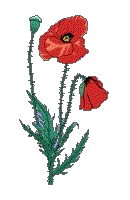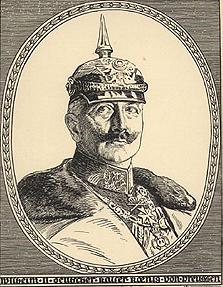
The
Western
Front
Museum
Last updated:
Living in exile
Castle Huis Doorn
Emperor Wilhelm II in Doorn
| 1859 27 January 1859 Berlin |  | 1941 4 June 1941 † Doorn |
The Kaiser signed all his official papers with the Latin initials I R which in fact stands for Imperator er Rex (Kaiser and King), but was later on in life translated as Immer Reisend (= always on the move) for his love for travelling.
Living in exile
With the end of the First World War in sight the situation in Germany became hopeless. On the 8th. November 1918 the revolution started in Munich, followed by Berlin the next morning. German High Seas Fleet had mutinied, and some of the Kaiser's most trusted regiments
raised the Bolshevist flag.
On the 10th. November 1918 at 04:30 am the Kaiser boarded the imperial train and started the 40 mile journey to The Netherlands. Arriving at the border at 07:30 am at the town of Eysen. After a six-hour delay (the border control was rather
confused by the Kaiser's arrival), he was allowed to pass into Holland and took up residence at Amerongen at the home of Count Bentinck.
On the 28th. November 1918 the Kaiser signed the official Act of Abdiction as King of Russia and Emperor of Germany. That same day the empress joined him at Amerongen.
In August 1919 he bought the estate in Doorn which needed at the time
a lot of modification before the Kaiser and his staff of 40 (officers and servants) could move into it. The main building was modified the most: staircases and lift were added, main entrance and main hall altered, plumbing and electricity modified.
Between September 1919 and February 1920 some five trains with a total of no less than 59 carriages with Hohenzollern's furniture from three different palaces found its way to Doorn.

In 1920 the Allies tried to extradite the Kaiser for a trail, but the Dutch government simply refused to cooperate.
Daily life at Huize Doorn revolved around the Kaiser. In the early years of his stay he devoted a lot of time to one of his hobbies: wood chopping. It is estimated that a total of no less than 40.000 trees were chopped down.
As a result of this many parts of the estate are without trees due to his almost daily wood chopping routines.
High point of the social year was the Kaiser's birthday on the 27th. January at which many princely personalities from Germany were often present.
As time passed the Kaiser became more and more a tragic figure until his death at the age of 82. He was buried in the garden of Huize Doorn in a small mausoleum, because the Kaiser considered the castle's garden as German soil. His body must stay there, as ordered in his will, until in Germany the monarchy is restored.
Castle Huis Doorn
If you happen to be in the neighborhood I suggest you visit the Huize Doorn. Not all rooms are open to the public, but those that are will show you - with the aid of a guided tour - a visit some 70 years back in time.
 |
Jam-packed with priceless items, and the Kaiser's personal belongings.
Not always in the best condition after all these years, but still very nice museum pieces.
 |
To create more space for the public they were forced to move a lot of the furniture, most of the Kaiser's uniform collection, and other
items to the attic which is unfortunately closed to the public. It makes you wonder what it would have looked like with all these items still in place. Overcrowded might be a slight understatement.
Open from 15th. September till 15th. May, Tuesday through Sunday 13:00 am - 17:00 pm; Open from 15th. May till 15th. September, Tuesday through Saturday 10:00 am - 17:00 pm, Open from 15th. Marc till 15th. November, Tuesday through Sunday 13:00 am - 17:00 pm; Admission € 6,50, child € 3,-.
Visit also Kasteel Huis Doorn's website for more details.
Sunday 13:00 am - 17:00 pm;
![]()
![]()
![]()
![]()
Member of the N.V.B.M.B.
(Dutch branch of the European Cartridge Research Association)
Copyright © The Western Front Museum Foundation